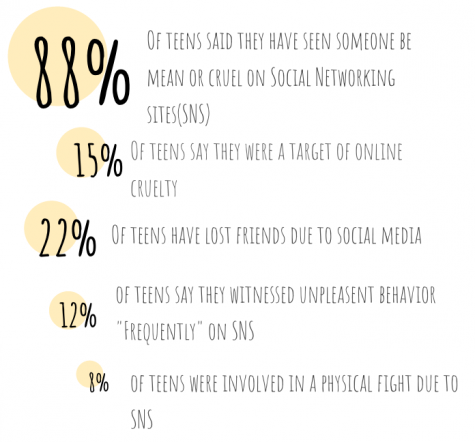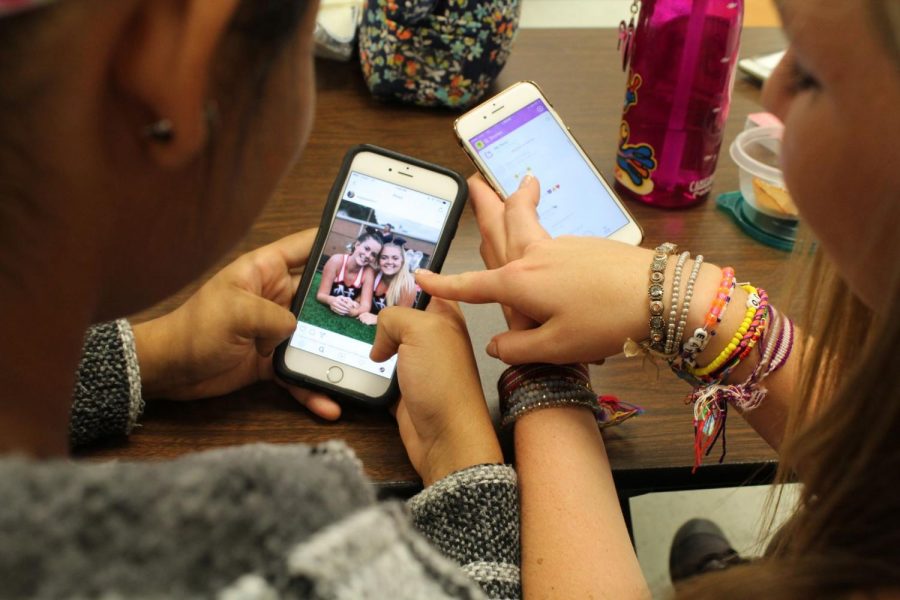Social media increases depression and anxiety in teens
Students avidly look through Instagram and Snapchat on a daily basis and slowly become consumed by it. Every day, students spend an abundant amount of time on their phones, affecting their friendships. “If I spent less time on my phone, I would be able to focus more on the moment and not be busy trying to record it,” junior Lauren Reagan said.
October 16, 2017
In today’s society, social networking sites (SNS) such as Instagram, Twitter, and Snapchat give teens and other people the ability to connect with friends both near and far. Sharing group events, parties, and other activities on SNS so that others can see represents a person’s life and social status. Recording events and for a friend’s online presence seems like a job or a responsibility. Teens quantify friendships using social media and compare their lives to other people’s. Modern social media sites, a recipe for disappointment, result in attractive profiles but disastrous attitudes.
The fear of missing out (FOMO), a common mental health syndrome found in teens, commonly results from an obsession with social media. Scrolling through Instagram could mean seeing all of the fun and excitement happening with other people and not you. Kids with FOMO anxiously check their phones in hopes of not seeing others excluding them. This creates the feeling of isolation in kids, resulting in loneliness, low self-esteem, and depression in certain cases. Teens affected by FOMO seem to believe that all their friends refuse to socialize with them. Kids picture their lives filled with loved ones and friends, right up until the time they see all their friends hanging out with other people on Snapchat or Instagram.
“When you’re an adolescent, you already have hormones and natural anxiety, and you turn to social media and technology. It’s kind of a fake way of establishing friendships. You’re very good at creating a facade, pretending everything is great, when you’re really at home miserable because of the party you weren’t invited to,” elected superior court official, Rebecca Keaton said.
Since Instagram’s launch on October 6 in 2010, 800 million individuals created accounts, with 500 million of those people as daily, active users. A poll in Culture Youth Studies reveals that 75% of teenagers own cell phones with 22% of them visiting social networking sites more than 10 times a day.
“Most people become addicts when they are teenagers because they turn to other things instead of their friends. Just like how people turn to social media for comfort and reassurance, but end up hurt. It happens all the time,” Keaton said.

The more technologically advanced and dependent kids become, the higher the possibility of teenage depression. Checking in on people while trying desperately not to miss out on anything becomes a natural routine. The way one keeps in touch with friends stays on just the tips of their fingers. As social media usage increases in teens, it continues to allow kids to compare their lives to others and feel self-conscious.
Twitter, another popular SNS, introduces a new type of connection between teens. The popular term subtweeting (subliminal tweeting), a gossiping trend, makes students’ drama public and makes it difficult for kids to stick up for themselves. In a subtweet, a person can simply spill their gossip without using the name of said person or mentioning their account. The tweet shows up on profiles and timelines, making anyone assume it involves him or herself. Tweeting serves the same purpose as gossiping out loud, except teens develop feelings of anxiety and worry since they can see the harsh comments on their timelines first hand.
“I feel like people who subtweet me should just confront me personally and not over social media where everyone can defend them and I can’t defend myself,” junior Lauren Reagan said.
Although studies failed to directly link social media usage to the increase of anxiety and depression in teens, recognizing the possibility of the correlation informs students and parents of the dangers of social media. Limited time online and on SNS reduces the stress of popularity and self-consciousness. While teens spend 9 hours consuming media a day,some 13 year olds even checking social media 100 times a day, kids should learn to live without their phones. If every teen spent half as much time on their phone, the risk of teen anxiety and depression would decrease incredibly.







